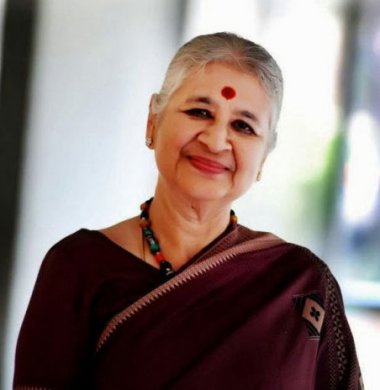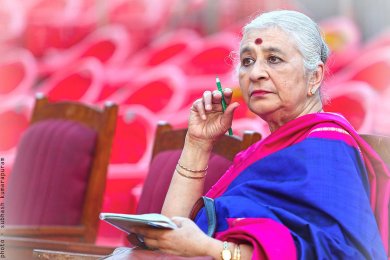
|
 |

|
 |
Reviewing the Reviewer - Madhur Gupta e-mail: madhurgupta04@gmail.com  Leela Venkataraman is a name to reckon with in the field of Indian arts and culture. A grand dame of art criticism in the country, Venkataraman has been a direct and indirect participant to several crucial moments in the development of Indian dance and music scene. Having actively participated in prestigious dance seminars and workshops including the likes of Odissi Festival and Seminar in Washington (and Malaysia); the International Kathak Seminar and Festival in Chicago; the Biennale de la Danse in Lyons, France; the now octogenarian critic has been a force shaping up the cultural scene of India in her own way. An SNA awardee, she has written, commented, and critiqued several generations of artists. We speak to her now and try delving into her own life's journey: Leelaji, could you share with us about your early life... I was born in 1936 in Chikmagaloor, Karnataka where my grandparents used to live and for some years after that I lived with my parents in Calcutta where my father was posted by the Indian Railways. Due to his continuous postings my father thought it'd be best if I stayed in one place to gain formal education so I came back to live with my grandparents who by this time had settled in Bangalore where I studied at Kamalabai School till my seventh grade. Since my parents missed me, by the time I turned 13, I was again sent for by them and back I went to Calcutta where I privately got enrolled in the Calcutta University passing with considerable distinction. Due to my father's transferable role I also got the opportunity to study at the prestigious Delhi College, Elphinstone College, and finally completed my graduation from the Agra University. In a way from very early on in life I got acquainted with different cultural aspects of the country which now I think in retrospect were helpful in giving me an open approach towards multi-faceted aspects of culture at large. After my marriage, my husband who was in the Indian Administrative Services was posted all around Orissa due to which unknowingly I became a spectator of the entire resurgence of Odissi. All the gurus, Pankaj Charan Das, Kelucharan Mohapatra, Debaprasad Das and others in the mid 50's were hard at work striving to give a national recognition to the dance form. I was fortunate to witness them reimagining and reconstructing Odissi as one of the classical dance styles of India. During this time, PV Krishnamurthy, the head of AIR in Orissa, called me over to compere a radio show for them. This led me to host various cultural functions in different government houses allowing me to be an indirect witness to the cultural revivalist movements which had firmly gripped the nation. From being master of ceremonies to art criticism, how did the paradigm shift happen?  I must tell you an incident during this time when one fine day I received a call and on the other line was Subbudu, the much revered/feared art critic in India. I must tell you my knees turned to jelly and I couldn't utter a word but Subbudu told me over that call that I wrote beautifully and I was shocked! Till then I was writing and associating with art events in various roles but this affirmation from such a pillar of great repute gave me the confidence to go ahead. During this time my stint with The Hindu also began when I got a call from Chennai stating that the editor is staying in a hotel in New Delhi and would like to meet me. The editor was Gopalan Kasturi himself and he told me that they are starting a Delhi edition, asking if I'd like to write for them. The interview would have lasted not more than half an hour and within two days I got a call from them requesting to start sending them my articles. What were/are the challenges of being an art critic? Since dance and music we review are very India specific, there are many regional and traditional terms which cannot be translated in English, so very evidently a language hurdle is faced. But as one keeps on writing, I feel one develops a sort of a vocabulary of one's own which defines the art well. One cannot translate word by word the traditional literature as that loses the essence, and that is the shortcoming of this popular medium of English. Of course the challenge of facing the wrath of artists whom one criticizes is always there but that does not deter me from thinking and writing what I think is right. One has to understand that this is a personal response of the critic and we as critics have to accept it as an occupational hazard where one receives ample amount of bouquets with an equal amount of brickbats too. Honesty and integrity are the ideologies to hold dear for any critic. Your comments on the dying art of art criticism... There was a time when so many reviews came out, people like Subbudu, Shanta Serbjeet, Srinivasan, V Menon, Sunil Kothari and others were commenting, discussing, creating dialogues in arts in all its glory. But we have not developed an attitude towards taking the critique in a healthy manner. Due to constant litigations, complaints, and sharp reactions from artists whose programs one analyzed, the newspapers gave up on the culture column altogether; the editors decided steadily it was better to just do away with the arts columns than deal with the drama. Plus there is no new blood in the scene sadly. No one is writing on the subject of arts. For one thing, the earning from dance criticism is peanuts, and then there are rarely any people informed well about our varied arts. One must look around, develop their own aesthetics, and maintain their integrity and sense of wonder towards the arts; such an attitude will create critical sensibilities towards culture. Contact Leela Venkataraman: leelakaverivenkat@gmail.com Comments * I would disagree on the absence of new blood... It's just that the established writers are preferred over younger writers. Young writers have to be given a chance. They may throw an entirely different perspective. - Durga (Aug 19, 2019) Post your comments Unless you wish to remain anonymous, please provide your name and email id when you use the Anonymous profile in the blog to post a comment. All appropriate comments posted with name & email id in the blog will also be featured in the site. |